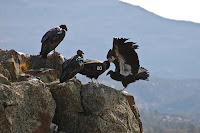Reminiscent of a vulture, the California condor is the largest
North-American land bird with a very limited area that it inhabits, with
populations ranging between the Grand Canyon area, Zion national park, coastal
mountains of central and southern California and northern Baja California. It
is also one of the world’s longest living birds, as it can reach ages up to 60
years old in the wild.
Despite this longevity, the Californian Condor population
declined drastically in the 20th century thanks to poaching, lead
poisoning and habitat destruction – this decline reached such a severe point
that eventually a conservation plan was put into place that culminated with the
capture of the 22 surviving wild condors that were put into breeding programs
to try and reverse the damage that has made the Californian Condor one of the
rarest bird species in the world; as of December 2011 there were only 390 in
existence, with 210 of these in the wild.
The California condor has played an extensive and important
role within the Native American culture. With a differing role for each tribe,
it has mythological and ritualistic importance that has led to it being revered
and hated, seen as a good luck charm or portent of bad fortune. Whilst this
would appear to be a good thing in some cases, both options have often led to
the condor being killed, either to fend off bad luck or to bring good luck to a
tribe. It is believed that this superstition gradually helped the slow decline
of the condor.
The low birth rates and mating habits of the condor have not
helped with the repopulating attempts that have been made, as the California
condor mates for life and only produce eggs every other spring. Scientists have
managed to increase the birth rates in some cases by taking eggs away from the
condor, which often ‘double-clutch’ (lay a replacement egg) when the first egg
is lost, eaten or stolen. This egg that is removed from the nest can then be
hand reared with a puppet and help increase the population further, whilst
there has been no loss in the wild.
Conservation efforts and breeding programs are slowly
starting to see an increase in the condor numbers across the Americas and
hopefully, given time, we will see the Californian condor expand across the
continent and flourish with new populations. Until that point, we can only hope
that breeding efforts continue to prove successful and the wild populations
grow strongly in the face of more and more land development that adds dangers
of power lines and a lack of prey species to feed on. The California condor is
no longer in as bad a position as it used to be in, but it will take a long
time before it is out of the danger zone.


No comments:
Post a Comment